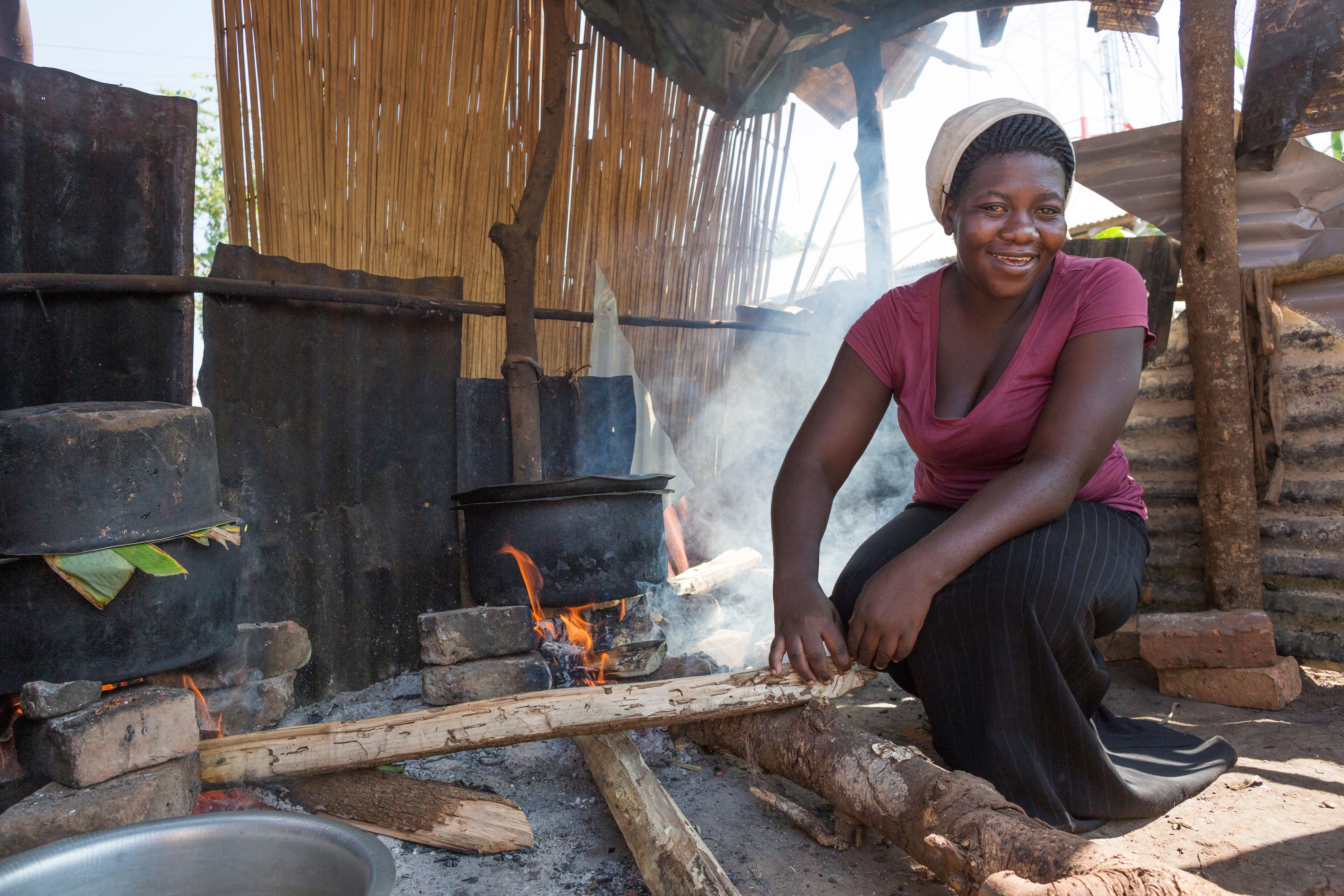To build sustainable livelihoods, there’s no one-size-fits-all approach
The provision of capital and assets is important, but a holistic approach to programming that considers local challenges is critical in facilitating truly sustainable livelihoods.
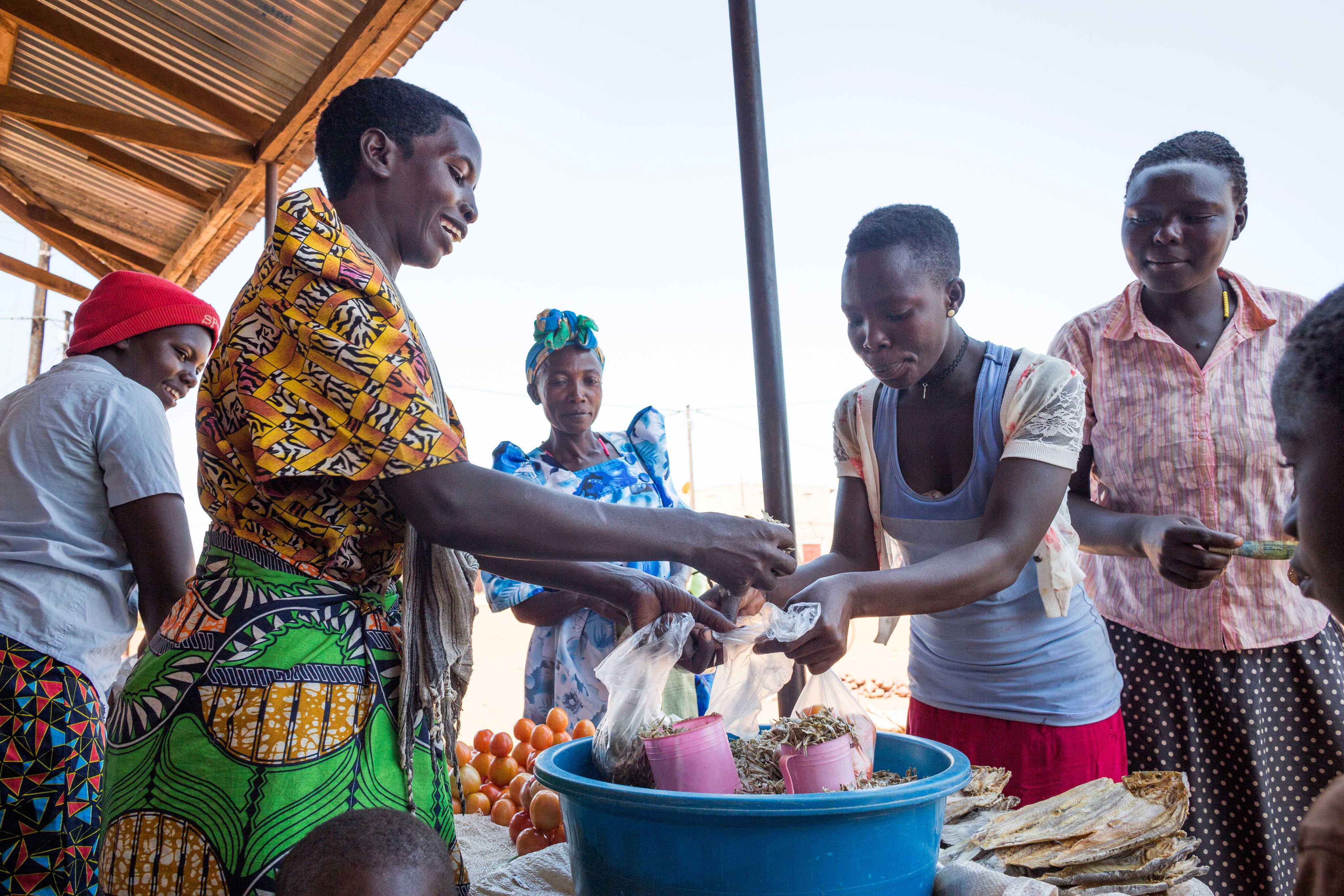
SPONSORED BY

Approximately half the world’s population still lives on the equivalent of about $2 a day, and when global shocks occur – whether a pandemic or climate disaster – it’s marginalized communities that face the greatest challenges in rebuilding their homes and livelihoods.
In northern Uganda, for example, traditional subsistence farming is the main source of food and income for many households, but extreme weather, such as prolonged droughts or floods, is putting families at risk of food insecurity. Poor infrastructure also makes it difficult for farmers to reach markets during the rainy season and sell what little extra they are able to grow. The region — which is home to 1.5 million refugees and is in some parts still recovering from the prolonged conflict with militant rebel group the Lord’s Resistance Army – has some of the highest poverty levels in the country, said Winnie Auma, the chief program officer at Village Enterprise, a nonprofit that fosters entrepreneurship and innovation in rural Africa.
People often lack the capital or knowledge to start their own business, Auma said, adding that through its poverty graduation program Village Enterprise aims to equip the most marginalized individuals in the region with the tools and resources to seize opportunities and lift themselves out of extreme poverty. However, this requires a range of approaches. “Providing capital or just cash is a quick fix, but it does not solve [the issue] … ending extreme poverty requires long-term and sustainable impact,” Auma said.
Photos: Cartier Philanthropy / Andrea Borgarello
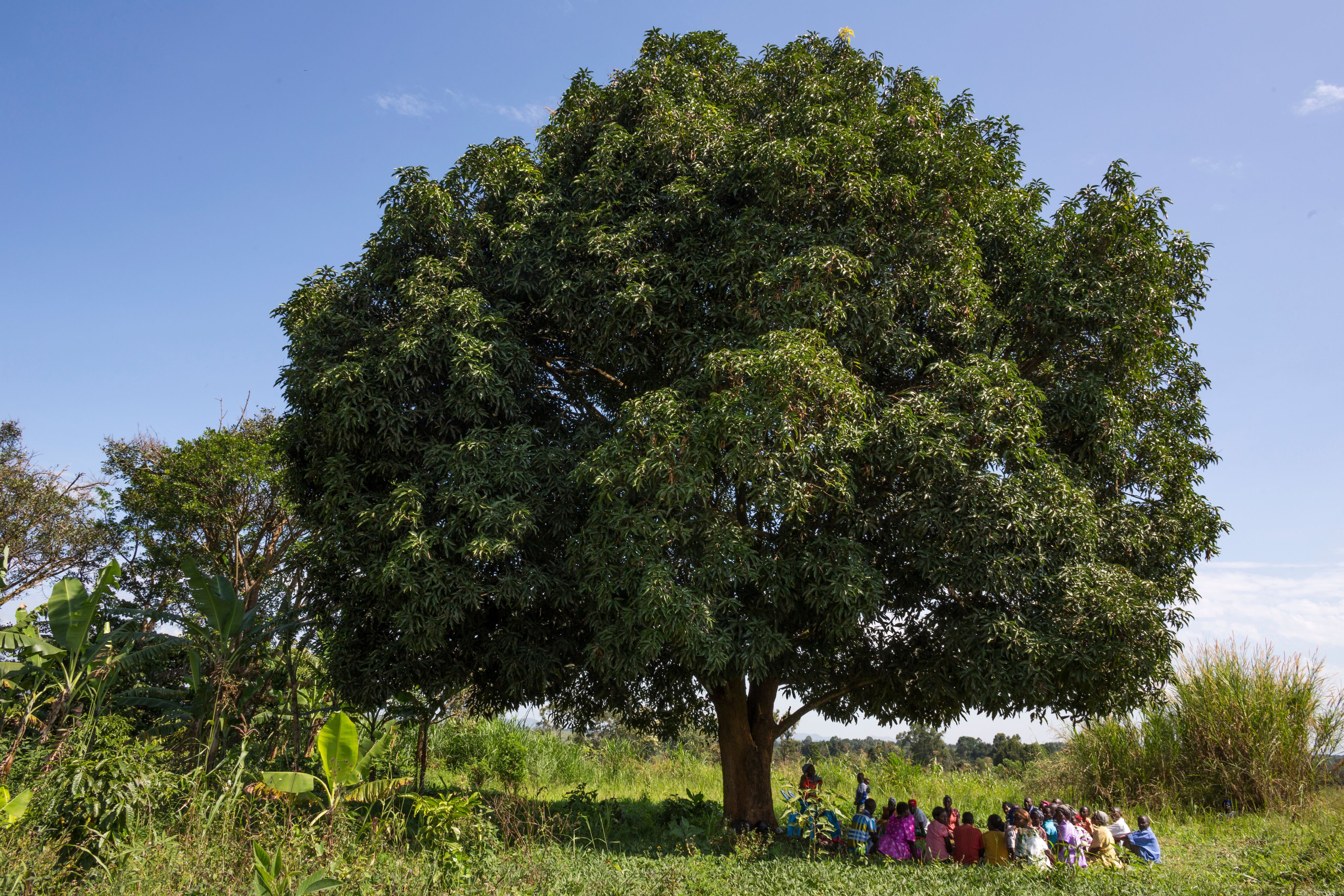
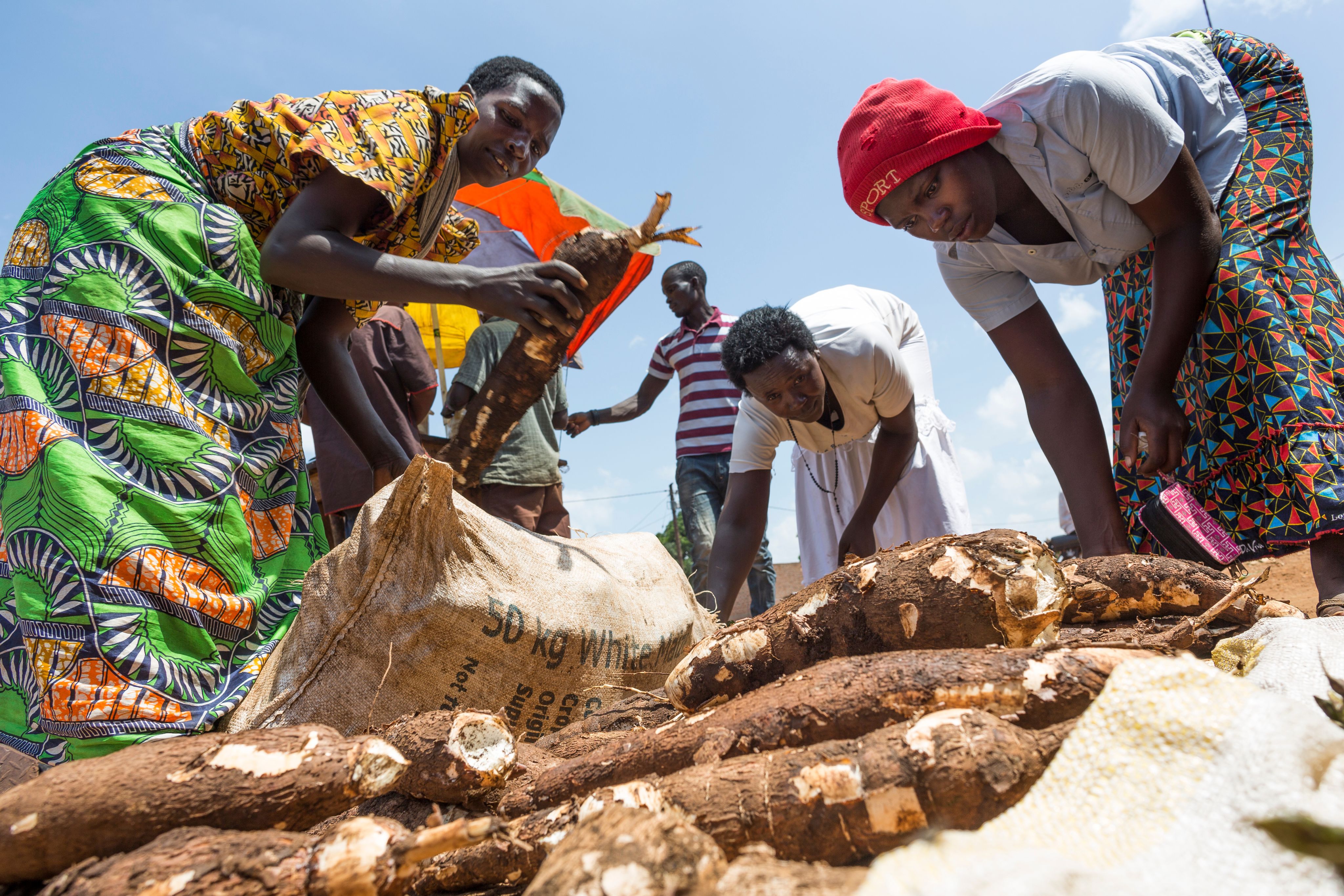
Reaching the most marginalized
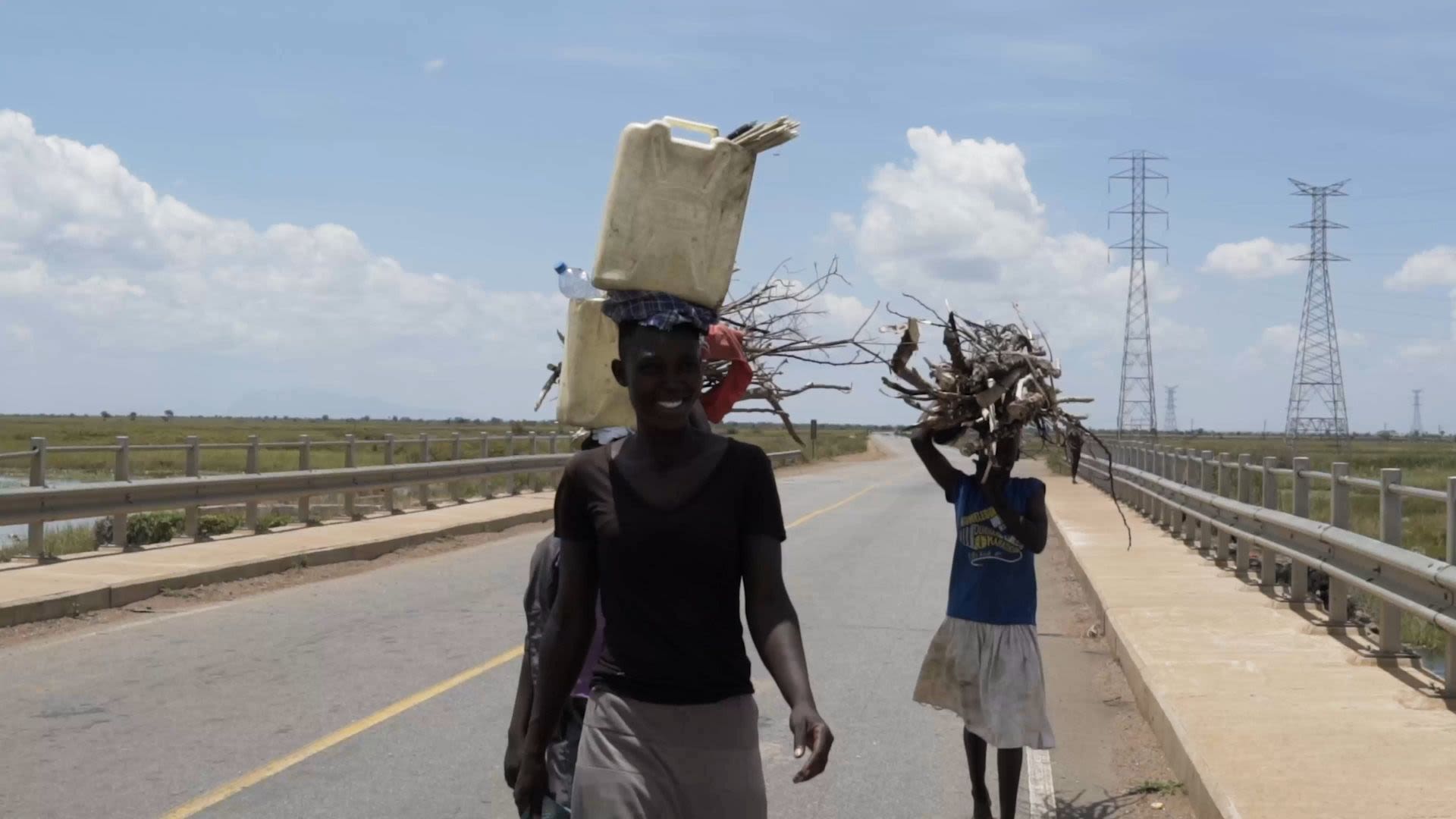
Women in Uganda in particular face significant obstacles in working outside the home and setting up their own businesses. They are limited in their mobility and access to land and resources, while also being disproportionately affected by global shocks, Auma said. But women’s participation is critical because “the more empowered women are, the stronger our societies [and] our communities,” she added.
Winnie Auma, chief program officer at Village Enterprise in Uganda, discusses the results of the development impact bond, released in March this year, which measured the poverty graduation program's success.
Women currently make up 83% of the entrepreneurs in Village Enterprise’s program. The team in Uganda is “very intentional” in its efforts to interact with marginalized households and speak with spouses and family members to ensure they will support women enrolling in the program. Activities and tools must also be adapted to reach different groups, Auma said. The surveys that the organization uses to determine the likelihood of poverty within households would not, for example, be suitable for working with refugee communities, and different poverty predictors are considered for these populations.
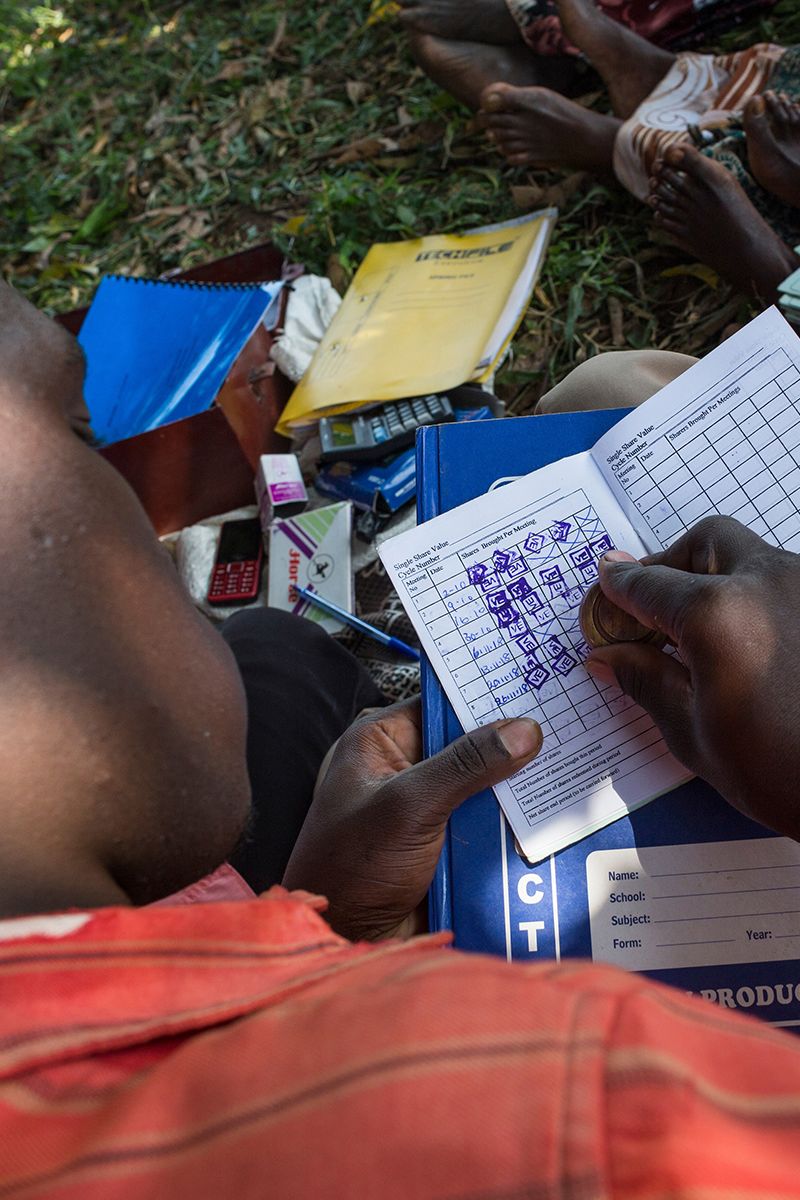
Village Enterprise aims to equip the most marginalized individuals with the tools and resources to seize opportunities and lift themselves out of extreme poverty. Photo: Cartier Philanthropy / Andrea Borgarello

Village Enterprise aims to equip the most marginalized individuals with the tools and resources to seize opportunities and lift themselves out of extreme poverty. Photo: Cartier Philanthropy / Andrea Borgarello
Village Enterprise aims to equip the most marginalized individuals with the tools and resources to seize opportunities and lift themselves out of extreme poverty. Photo: Cartier Philanthropy / Andrea Borgarello
Village Enterprise has been working in Uganda for three decades.
During that time, it has supported the establishment of 31,000 businesses and the training of over 110,000 first-time entrepreneurs.
Participants have seen a 45% increase in annual average income for households that complete the poverty graduation program.
Through partnerships, the organization supports South Sudanese refugees and their host communities to start sustainable micro-enterprises in three refugee settlements in Uganda’s West Nile region: Rhino Camp, Bidibidi, and Palorinya.
In neighboring Rwanda, Women for Women — an organization supporting female victims of war and violence to rebuild their lives — works with community leaders to identify the most marginalized women and get their families on board with its training program. “We have learned over the years that we need the family’s permission for the woman to join the program, otherwise it won’t work,” said the organization’s CEO Laurie Adams. “Before we even invite women to enroll, we do a lot of sensitization with the community … and we [lead with] data and proof that [women establishing businesses] is good for the community and the families.” Some women also choose a male family member to attend the Men’s Engagement program, which educates them on gender inequalities and rights.
Women for Women Rwanda Program Manager Catherine Kampire Gashegu explains how the organization's psychosocial support helps vulnerable women to gain confidence.
One of the many success stories is Caritas Mukagatana who returned to Rwanda, having fled during the 1994 genocide and the loss of most of her family. With entire communities and livelihoods destroyed, Mukagatana had to find a way to feed her two children and those of her brother-in-law. She received training in beekeeping — a traditionally male-dominated field in Rwanda — and is now the president of a beekeeping cooperative with 125 members who earn a living through harvesting the honey and supporting each other in tough times.
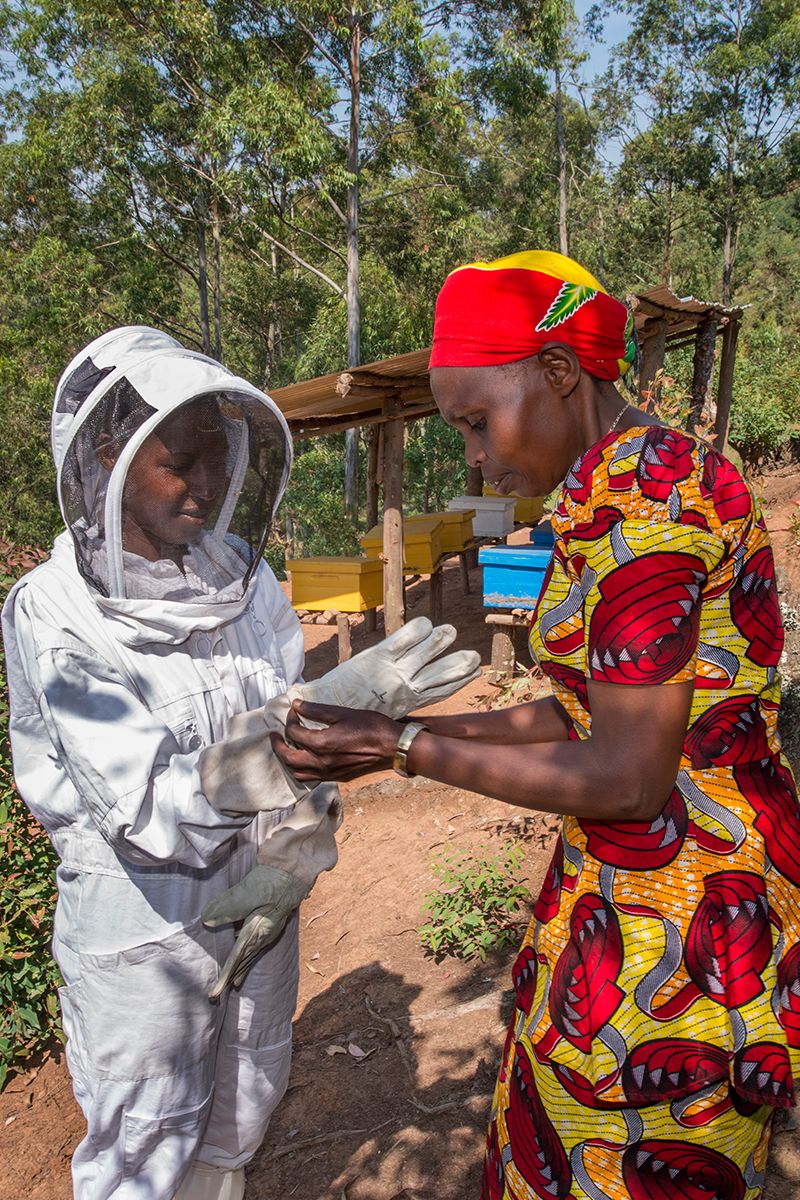
Caritas Mukagatana retrained in beekeeping — a traditionally male-dominated field in Rwanda — and is now the president of a beekeeping cooperative. Photo: Women for Women International / Alison Wright

Caritas Mukagatana retrained in beekeeping — a traditionally male-dominated field in Rwanda — and is now the president of a beekeeping cooperative. Photo: Women for Women International / Alison Wright
Caritas Mukagatana retrained in beekeeping — a traditionally male-dominated field in Rwanda — and is now the president of a beekeeping cooperative. Photo: Women for Women International / Alison Wright
Women for Women has reached over 79,000 women since it began working in Rwanda.
Currently, 300 women are enrolled in the organization’s Stronger Women, Stronger Nation program. 19% of these participants have no formal education.
Between 2017 and 2020, participants in the program in Rwanda saw a 135% average increase in monthly earnings and 558% average increase in monthly savings.
Last year, 10,350 women graduated from the program having learned skills in areas such as beadwork, food processing, hairdressing, tailoring, and tourism and hospitality.
Contextualized programming

Despite producing most of the world’s food, smallholder farmers tend to be food insecure themselves and globally make up the majority of people living in poverty, according to the World Food Programme. Where livelihood programs provide agriculture assets, such as seeds or livestock, they must therefore also offer additional support to help participants overcome local challenges.
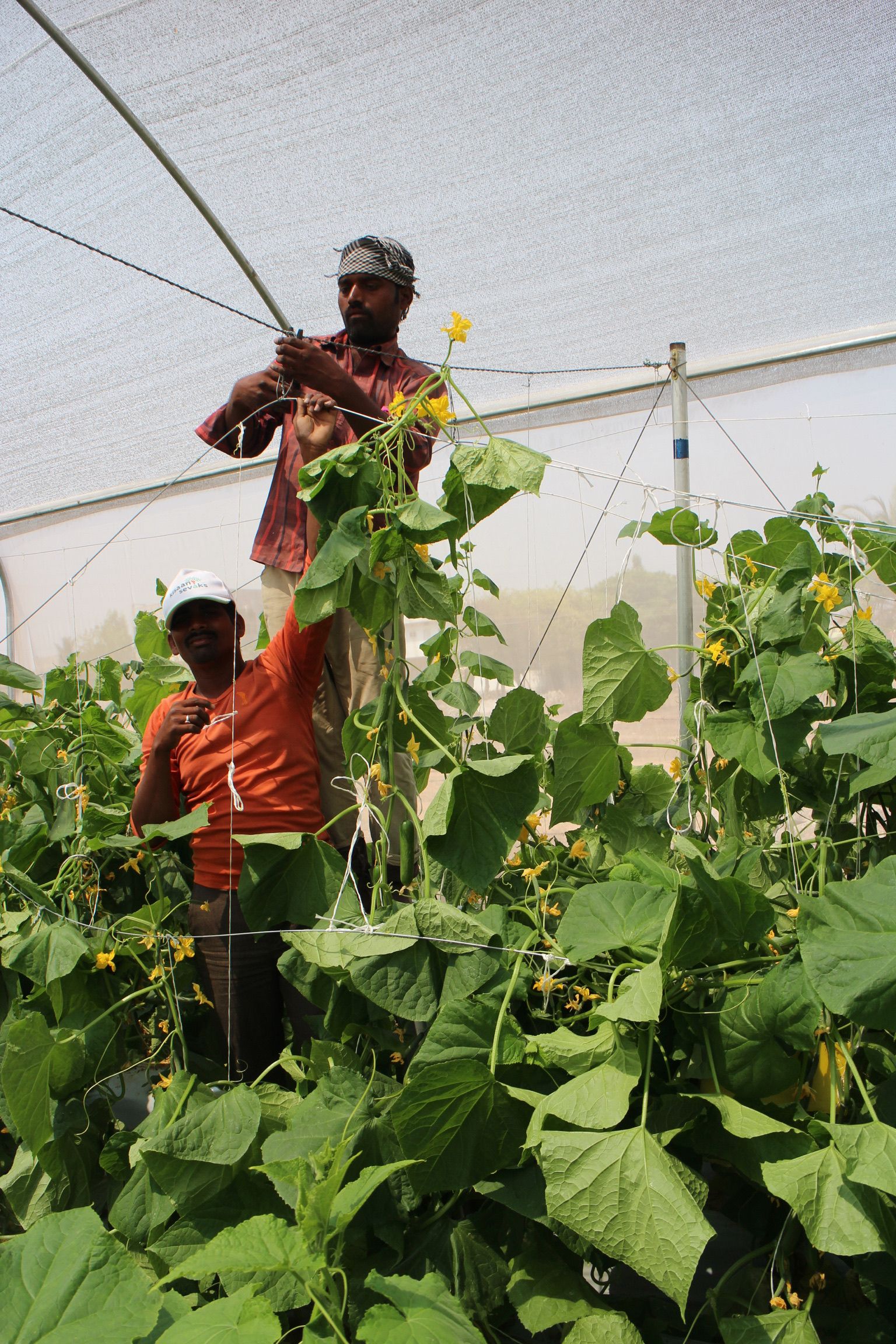
Kheyti's greenhouse-in-a-box is half the cost of a regular greenhouse and uses 90% less water. Photo: Kheyti / Janice Cantieri
In India, 75% of farmers own less than 1 hectare (2 acres) of land, with a further 10% working on less than 2 hectares. That’s approximately 85 million families — or the equivalent of 400 million people — depending on small farms for their livelihood, explained Kaushik Kappagantulu, the co-founder and CEO of Kheyti, an organization that provides technology solutions for the country’s small-scale farmers. But for some years already, unpredictable weather, such as reduced or sporadic rain, has been impacting crop yields and making it difficult for farmers to earn a living.
Kappagantulu’s team set out to design a solution that would do three things: increase farmers’ incomes, make agricultural practices more sustainable, and improve resilience to climate risks. “It couldn’t be a one-sided solution. … It [had] to solve these three problems,” or in 10 years, the farmers would be no better off, he said. The greenhouse-in-a-box — a modular greenhouse — that Kheyti now provides to over 1,000 farmers, at half the cost of regular greenhouses, uses 90% less water but still allows small farmers to increase production by protecting the crops from extreme weather events.

Kheyti's greenhouse-in-a-box is half the cost of a regular greenhouse and uses 90% less water. Photo: Kheyti / Janice Cantieri
Kheyti's greenhouse-in-a-box is half the cost of a regular greenhouse and uses 90% less water. Photo: Kheyti / Janice Cantieri
Kheyti is currently working with 1,000 small-scale farmers in six states of India.
The greenhouse-in-a-box uses 90% less water but still allows small farmers to increase production by protecting crops from extreme weather conditions.
In 2018-2019, farmers adopting the Kheyti greenhouse saw a 60% increase in their incomes.
The organization aims to reach 50,000 farmers by 2027.
Human-centered design — or farmer-centered design — has been key to producing a lower-cost solution and, as a result, allowing more farmers to enroll and pay in affordable installments, said Kappagantulu. By listening to their needs through a mixture of one-to-one interviews, shadowing, focus group discussions, and feedback surveys, the team was able to find ways to design greenhouses that better matched the needs of small-scale farmers. This included making smaller greenhouses that require less concrete for the foundation and use lower-cost materials, making it easier for farmers to install the structure themselves.
In Uganda, Auma’s team is also using human-centered design to better understand what trades and livelihoods are of interest to the communities they support. Her team encourages enterprise diversification to ensure households are resilient to different shocks. Nonfarming income-generating activities can range from running restaurants, small shops, and hairdressing salons, to providing transportation services. For those who pursue farming, the training teaches climate-smart practices such as crop rotation and use of drought-tolerant seeds.
Nathanael Goldberg, a senior director at Innovations for Poverty Action, noted the importance of offering a menu of different and appropriate livelihood paths that consider the skill level and land access of communities, or the household responsibilities that fall to women. Across many livelihood programs in Africa, rearing goats is the “classic livelihood” for women because it can be done with little land and close to home, he explained. But in other regions, other livestock might be more common.

The design requires less concrete for the foundation and uses lower-cost materials, making it easier for farmers to install the structure themselves. Photo: Kheyti / Janice Cantieri
The design requires less concrete for the foundation and uses lower-cost materials, making it easier for farmers to install the structure themselves. Photo: Kheyti / Janice Cantieri
A holistic approach

Designing effective livelihood programs requires an “understanding that it’s not going to be a straightforward path out of poverty,” Goldberg said. While it’s important to provide skills training, assets, and access to savings groups — where members meet regularly to save together and lend to one another — challenges arise that require life skills and support networks, he added.
IPA conducts evaluations of development programs to find and share the most effective models. Goldberg pointed to one unsuccessful asset-based program in Ghana that was implemented without coaching. Households were identified and targeted in similar ways to other graduate programs and provided with assets. However, two years later, they were no better off. In contrast, “the people who received the holistic version of the program with all the aspects, including coaching, had made numerous improvements in their household welfare,” Goldberg said.
Early on, Kappagantulu’s team in India realized that the technology alone was not enough — the farmers his organization works with live in hard-to-reach rural areas and are often disconnected from the supply chain. Through the greenhouse-in-a-box initiative, farmers receive training on seed planting, the use of technology to increase yields, and where to sell their produce. Ongoing support is also available from technical staff via WhatsApp. “Our work really starts after the greenhouse is bought and installed because our relationship with the farmer is multiyear,” Kappagantulu said.
Women for Women’s program helps participants develop skills in trades such as tailoring, coffee agribusiness, and basket making, and facilitates employment opportunities through business partnerships. But the curriculum also provides psychosocial support and equips the women with knowledge of their rights and the skills to make decisions at home and in the community. The program aims to help women “believe in themselves,” Adams said. “If you have no money, your power to choose is highly limited because you're dependent on somebody else, but if you have no self-confidence, you will abrogate your decision-making.”
Photos: Kheyti / Janice Cantieri
Cartier Philanthropy / Andrea Borgarello

